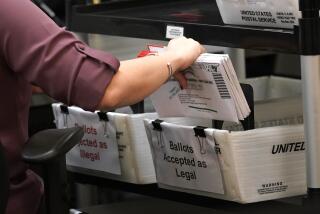Riverside’s Investment in Making the Chad Obsolete
- Share via
Unless we get busy, our next presidential election is likely to be monitored by observers from El Salvador and Mexico. Everybody knows that the voting machines in Florida left us with thousands of ballots on which people voted for two candidates for the same office, erroneously voted for the wrong candidate or left vote counters baffled when they dimpled a chad or left one hanging by two or maybe three corners. Since we have sent observers to watch Latin American elections, it is only fair, I suppose, that they now send their own back to watch us.
But the problem is not limited to Florida; it exists in every state. Florida made the news because there was a legal challenge to how people voted in an extremely close and politically vital state.
To make matters worse, former President Bill Clinton has said that he “knows” that Al Gore really won the Florida contest, though I doubt he can explain why he is certain of that. And Gore has said that only a manual recount would be “objective,” when the very design of the ballot makes any manual recount inherently invalid.
So there is nothing objective about a manual recount. But the Republicans should realize that there is nothing objective about letting machines read punched ballots, either. Machines that read punch cards or scan sheets on which the voters have filled in a circle will make mistakes; the cards can be wrongly or imperfectly punched, and the circles can be filled with a check or some other misleading mark.
In every Florida county and throughout most other states, the problem of getting an accurate count cannot be solved by the systems now in use. Paper ballots can be miscounted by people. Machines that read punch cards will often be unable to decide whether the chad has been completely punched out, and hand counts of punch cards will be as subjective as hand counts of paper ballots. Moreover, these systems take time to record their votes, and, during this period, media projections of who won--not always accurate--proliferate.
It is baffling why we cannot count all our ballots precisely and swiftly. But in Riverside County, they do just that. Mischelle Townsend, the county registrar of voters, has installed an electronic voting system that makes it next to impossible for people to vote for the wrong candidate and completely impossible for them to vote for two candidates for the same office. It is the first countywide touchscreen system in the country.
Manufactured by Sequoia Pacific Voting Equipment of Exeter, Calif., the device is an electronic screen much like that on the front of an automatic teller machine. After voters have verified their identity with the precinct worker, they enter booths carrying a smart card. When they insert the card in the machine, the ballot appears in front of them. If the law requires that the ballot appear in several languages, voters can pick the language they prefer.
Opposite each candidate’s name is a circle. When the voter touches the circle, a green check mark appears indicating that he has voted for that person, and the circles next to the names of the other candidates disappear. After making all his choices, the voter can review the whole ballot and change any selection. Then he presses the “cast vote” button and the vote is recorded electronically in the machine and on a results cartridge. The cartridges, stored in sealed bags, are then taken to a central computer where the results are read as soon as the polls have closed.
No election worker ever needs to stare at a chad to see if it is hanging by one corner or two or three or worry whether a dimple in the middle of a punch-card slot means the voter tried to vote there. Nobody using the Sequoia system could have voted for both Gore and Pat Buchanan. In theory, a Gore voter could mistakenly vote for Buchanan, but it would take astonishing stupidity to do so, since the green check mark next to “Buchanan” would have been lit up on the electronic screen and the circle next to “Gore” would have disappeared.
If there is a power failure, batteries installed in each voting machine back up the results for three hours; if the power failure continues, new backup batteries can be installed. The electronic screens can be adjusted so that voters in wheelchairs can see them and equipped with headphones so that blind voters can hear their vote.
Riverside was a good county in which to test the system, since it has a lot of retired residents. If older folks are more likely to get confused with ballots, that didn’t happen in Riverside. And elections there often are close; a city council member lost by one vote in 1999. In addition, ballots in California are incredibly complex because there are so many local and state initiatives as well as electoral candidates. When she was still using paper ballots, Townsend had to print up scores of different combinations at a cost a few years ago of more than $1 million per election.
The machines cost about $3,100 each. Riverside put five to 10 in each polling place at a total cost of $14 million. To do this, Townsend had to persuade a lot of skeptical people that the investment was worthwhile.
After seeing what happened in Florida, no one is skeptical any longer.
More to Read
Get the L.A. Times Politics newsletter
Deeply reported insights into legislation, politics and policy from Sacramento, Washington and beyond. In your inbox twice per week.
You may occasionally receive promotional content from the Los Angeles Times.










